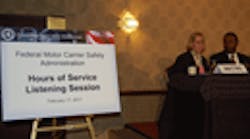CRYSTAL CITY, VA. The Federal Motor Carrier Safety Administration (FMCSA) is now in favor of limiting truck drivers to just 10 hours behind the wheel under its hours of service (HOS) reform proposals. That is a reduction of an hour from the 11-hour drive time limit in effect under the current rules. However, that being said, the agency won’t make a final decision until it receives all the comments from the ongoing “listening sessions” it’s conducting.
“We currently favor a 10-hour driving time limit, but our ultimate decision will include a careful consideration of all the comments that we receive and the testimony we hear at this listening session,” said Larry Minor, FMCSA Associate Administrator of policy and program development, at the session held here yesterday.
“So we haven’t made up our minds as to whether it will be 10 or 11 hours yet, but we prefer 10 hours,” he stressed.
See video from the HOS listening session
Fleets at the FMCSA listening session were quick to provide data showing that the agency’s HOS proposals would negatively impact their operations.
“We calculated that the productivity impact of the proposed rule would be a negative 4.27%,” said Don Osterberg, senior vp-safety and security for Schneider National. “We also found under the current proposal that we would get [our] drivers home 25% less than we do today.”
He added that Schneider’s “baseline” length of haul of 501.7 miles would shrink to 478 miles. And that 24-mile per-day decline would mean the carrier would have to increase its driver pay by roughly $3,000 per year per individual to compensate for the mileage reduction.
“That [pay increase] is probably appropriate anyway, considering the market we are going into, with [personnel] supply and demand being what it is, I think we’re going to have to increase driver pay,” Osterberg noted. “But this is certainly an element that is going to add cost to the supply chain.”
Bob Petrancosta, vp-safety for Con-way Freight, said his company completely overhauled its entire operation to maximize efficiencies based on the 11 hour drive time limit – changes that would come with a huge price tag if they had to be undone.
“Since the current HOS rules went into effect in 2004, we reduced the number of terminals in our system from 500 to 365,” he said. “Moving back to a 10-hour drive time limit would disrupt the movement of freight within our system and force us to realign both infrastructure and assets, while relocating many of our employees. We’d also need more drivers to service the same amount of freight and would be forced to put more trucks on the road during the daytime.”
Safety advocates, however, are generally pleased with the FMCSA’s stance favoring a 10-hour drive time limit. But Henry Jasny, general counsel of the Advocates for Auto and Highway Safety (AAHS), said they’d prefer an 8-hour drive time limit.
“In our view, we would like drive time to stay at eight hours, but we know the agency won’t propose that,” he stated. “So if the best we can get is 10 hours that is acceptable. We think this is a reasonable restriction and the industry functioned under it for decades.”
See video from the HOS listening session
He added that the groups he represented – which included Public Citizen and the International Brotherhood of Teamsters as well as AAHS – also wanted to do away with the 34-hour restart provision entirely. “We think this is far too short a time period for drivers to gain restorative sleep,” Jasny said.
Barring that, he said the agency’s proposal to mandate two back-to-back midnight to 6 a.m. off-duty periods to use the 34-hour restart provision acceptable. “But if you really want a simple rule with less complexity, get rid of the 34-hour restart,” Jasny stressed. “This has made the HOS rules more complicated.”
Yet John Spiros, vp-safety and claims management for Roehl Transport, noted that the midnight to 6 a.m. break could actually lead to more problems, forcing drives to start their work day at often the most heavily congested period on major urban roadways. “Some cities, like Atlanta and Boston, actually restrict trucks from operating at that hour,” he explained. “So this part of the proposal would actually complicate the lives of all the stakeholders involved in this issue.”
Todd Spencer, executive vp of the Owner-Operator Independent Drivers Assn. (OOIDA), said the ultimate problem with FMCSA’s reform effort is that it’s trying to forge a rigid “one-size-fits-all” set of rules on an industry that encompasses many different styles of operations.
“For example, certain hazmat [hazardous materials] and DoD [Department of Defense] shipments demand that drivers can’t take breaks for safety and security reasons, yet under these new [HOS] regulations drivers must take a 30 minute break,” he noted.
“Trucking is such a diverse industry, yet the goal here is one rule applicable to all,” Spencer stressed. “That just won’t work because one rule doesn’t make sense for all.”
What’s also needed is more flexibility within the rules, so carriers and drivers alike can “work around” all the other parties involved in the supply chain, he said.
“Remember that truck drivers don’t set their schedules,” Spencer explained. “They bump up against that 14 hour on-duty work day limit because they’ve been held up at a dock for six or seven hours. By our calculations, truck drivers spend an average of 30 to 40 hours per week waiting at docks. That is because shippers and receivers put their efficiency needs ahead of the rest; that is where the focus needs to be.”
That’s why truck drivers can’t be held to rigid HOS rules, he stressed. “You can’t ignore the environment that they live in,” Spencer added. “We want drivers to be given the tools and support so they can drive when they are fresh and can rest when they need to.”



